Task groups in Classic pipelines
Azure DevOps Services | Azure DevOps Server 2022 - Azure DevOps Server 2019
In Classic pipelines, a task group encapsulates a sequence of tasks that are already defined in a pipeline into a single reusable task. The new task group is automatically added to the task catalog, and can be added to pipelines in the project just like other tasks. Task groups are stored at the project level, and aren't accessible outside the project scope.
Task groups are a way to standardize and centrally manage deployment steps for all your applications. When you make a change centrally to a task group, the change is automatically reflected in all the pipeline definitions that use the task group. You don't need to change each definition individually.
Note
Task groups are not supported in YAML pipelines. Instead, you can use Templates.
Prerequisites
- An Azure DevOps organization and project where you have permission to create pipelines.
- A Classic pipeline created in the project.
Extract task parameters as variables
When you create a task group, you can choose to extract the parameters from the encapsulated tasks as configuration variables, and abstract the rest of the task information. Variables used in the tasks are automatically extracted and converted into parameters for the task group, and values of these configuration variables are converted into default values for the task group.
You can also change the default values for the parameters when you save the new task group. When you queue a pipeline run or release, the encapsulated tasks are extracted and the values you entered for the task group parameters are applied to the tasks.
Before you create a task group, make sure to define any parameters that you want to be able to configure in pipeline runs as variables, such as $(MyVariable). Any task parameters that have no values or have specified values instead of variables become fixed parameters and aren't exposed to the task group as configurable parameters.
You can also configure task conditions in a task group, such as Run this task only when a previous task has failed for a PowerShell Script task, and these conditions are persisted with the task group.
Note
Task groups are supported in Classic pipelines and Classic release pipelines.
Create a task group
When you save a new task group, you provide a name and description and select a category for the task group in the task catalog.
Open the pipeline where you want to create a new task group.
To ensure that none of the tasks you intend to include contain any linked parameters, select Unlink all in the pipeline settings panel, and then select Confirm.
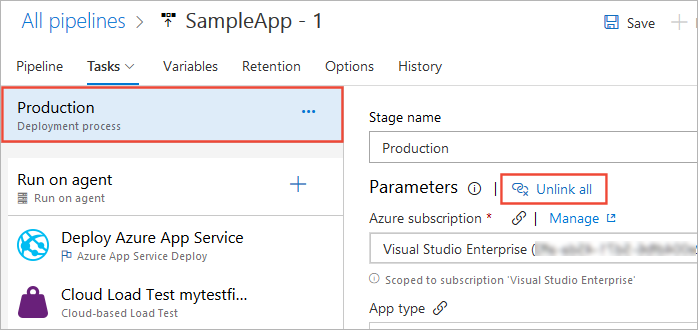
Select a sequence of pipeline tasks that you want to turn into a task group, right-click to open the context menu, and then choose Create task group.
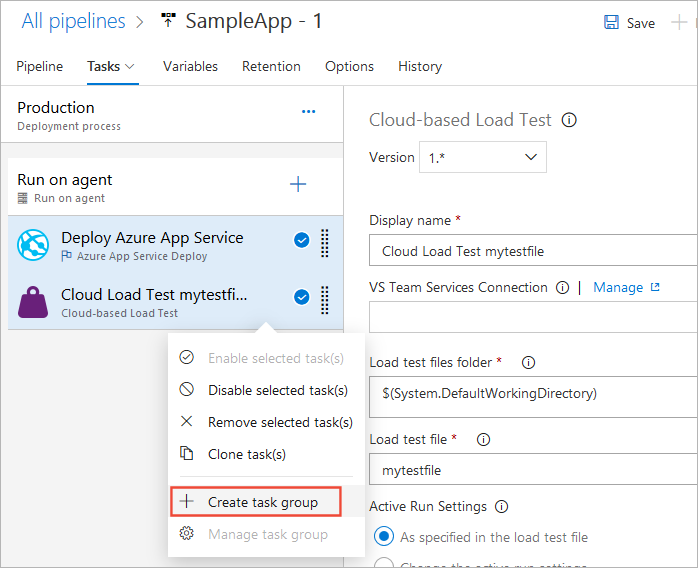
Specify a name and description for the new task group, and the category in the Add tasks pane you want to add it to.
Select Create. The new task group is created and replaces the selected tasks in your pipeline.
All the
'$(vars)'from the underlying tasks, except predefined variables, surface as the mandatory parameters for the newly created task group, and you can edit the values if necessary.For example, if you had a task input
foobarthat you didn't intend to parameterize, the task input is converted into the task group parameter'foobar'. You can provide the default value for the task group parameter'foobar'as$(foobar)to ensure that at runtime, the expanded task gets the input you intend.Save your updated pipeline.
Manage task groups
All the task groups in the current project are listed under Pipelines on the Task groups page.
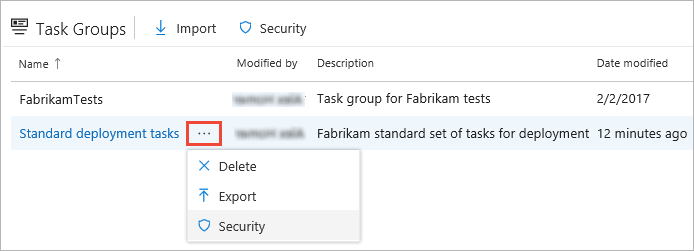
At the top of the Task groups page, you can select Import to import previously saved task group definitions. You can use this feature to transfer task groups between projects and enterprises, or replicate and save copies of your task groups.
You can also select Security at the top of the page to define who can use, edit, delete, or set permissions for all task groups in the project.
To manage a task group, right-click or select the More actions icon for the group, and select one of the following options from the context menu:
- Select Delete to delete the task group, and then select Delete again on the confirmation screen.
- Select Export to save a copy of the task group as a JSON pipeline.
- Select Security to define who can use, edit, delete, or set permissions for the task group.
To open the task group details page for editing, select the task group name on the Task groups page.
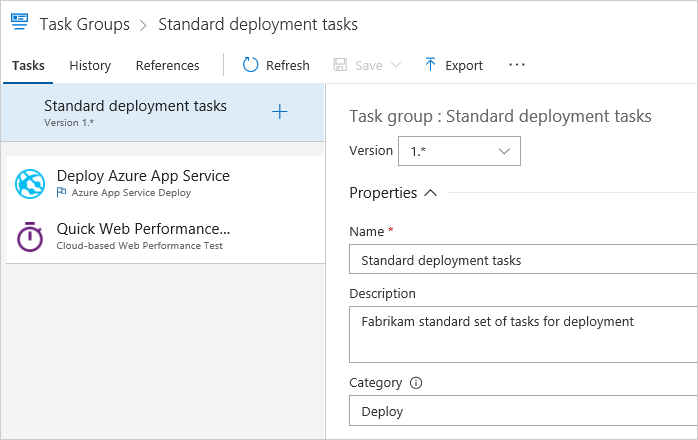
On the Tasks tab, you can edit the tasks that make up the task group. For each encapsulated task you can change the parameter values for the nonvariable parameters, edit the existing parameter variables, or convert parameter values to and from variables. When you save the changes, all definitions that use the task group pick up the changes.
All the variable parameters of the task group appear as mandatory parameters in the pipeline definition. You can also set the default values for the task group parameters.
On the History tab, you can see the history of changes to the group.
On the References tab, you can see lists of all the pipelines and other task groups that reference this task group. This listing helps you ensure that changes don't have unexpected effects on other processes.
Create preview and updated versions of task groups
All built-in Azure Pipelines tasks are versioned. Versioning allows pipelines to continue using the existing version of a task while new versions are developed, tested, and released. You can version your custom task groups the same way to provide the same advantages.
To version a task group, after you finish editing it, select Save as draft instead of Save.
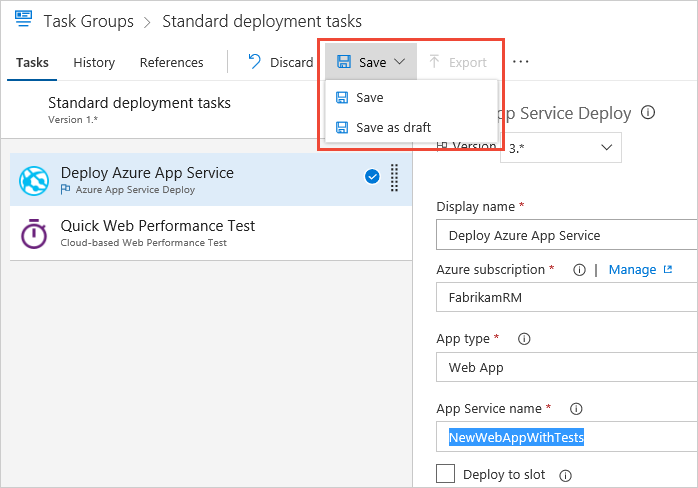
The string -test is appended to the task group version number. When you're happy with the changes, choose Publish draft. On the Publish draft task group screen, select Publish as preview if you want to publish the new version as a preview, and then select Publish.
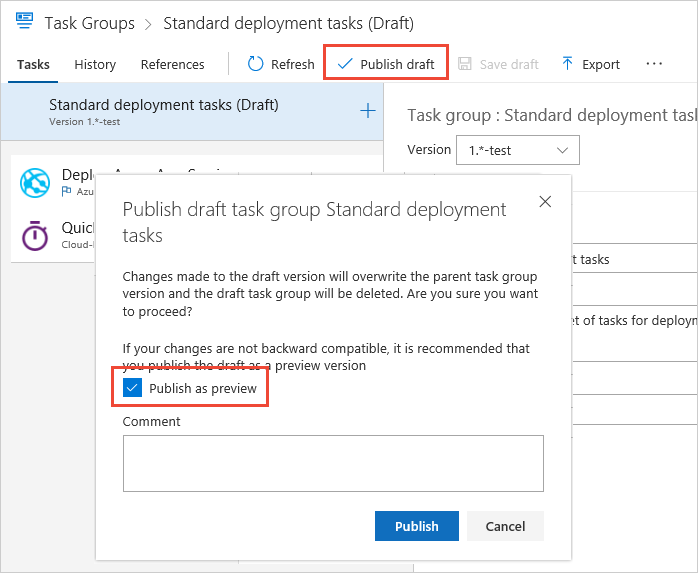
You can now use the updated task group in your release processes. You can either change the version number in pipelines that already use the task group, or choose the versioned task group from the Add tasks pane. As with built-in tasks, the default when you add a task group is the highest non-preview version.
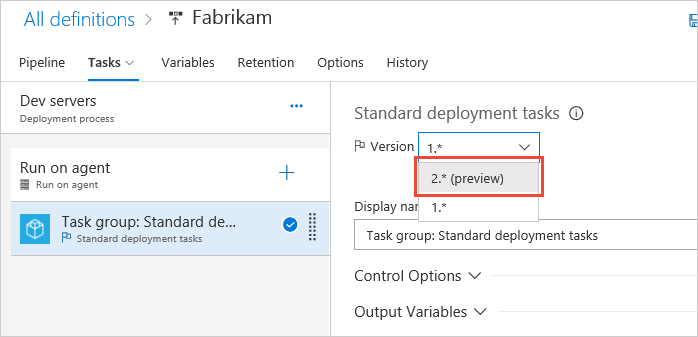
After you finish testing the updated task group, choose Publish preview, and then select Publish. The Preview string is removed from the version number, and the version now appears in definitions as a production-ready version.
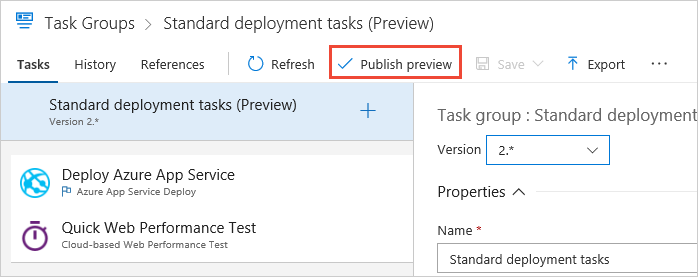
You can now select the new production-ready version in a pipeline that already contains the task group. When you add the task group from the Add tasks panel, it automatically selects the new production-ready version. You can edit the pipeline to use an earlier version.
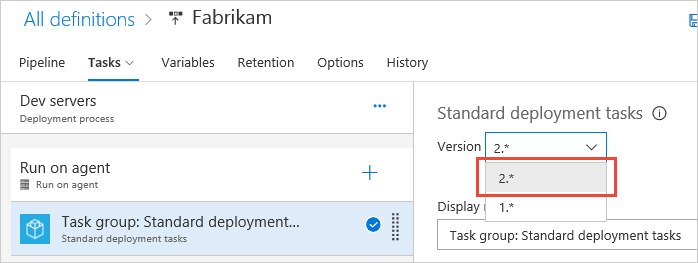
Work with task group versions
Task group updates can be minor or major version updates.
Create a minor version update
To create a minor version update, you directly save the task group after editing it instead of saving it as a draft.
The version number doesn't change, and the latest changes show up in the pipeline definition automatically. For example, if your task group is version 1, you can have any number of minor version updates such as 1.1, 1.2, and 1.3. In your pipeline, the task group version shows as 1.*.
Use minor version updates for small changes in the task group, when you expect pipelines to use the new change without changing the version number in the pipeline definition.
Create a major version update
To create a new major version, you save the task group updates as draft and create a preview, validate the changes, and then publish the preview.
This process bumps up the task group to a new version. If you had a task group with version 1.*, new versions are published as 2.*, 3.*, 4.*, and so on.
A notification about new version availability appears in all the pipeline definitions that use the task group. Users must explicitly update to the new task group version if they want to use it in their pipelines.
When you make substantial changes that might break existing pipelines, you can test and roll out the changes as a new major version. Users can choose to upgrade to new version or stay on the current version. This functionality is the same as a regular task version update.
Test a minor version update
If your task group update isn't a breaking change, but you want to test first and then force all pipelines to use the latest changes, follow these steps:
- Save the task group changes as a draft. A new draft task group named <Taskgroupname> (Draft) is created with your changes.
- Add this draft task group directly to your test pipeline.
- Validate the changes in your test pipeline. Once you're confident in the changes, go back to your main task group, do the same changes, and save them directly. The changes are saved as a minor version update.
- The new changes now show up in all the pipelines that use this task group. Now you can delete your draft task group.
Help and support
- Explore troubleshooting tips.
- Get advice on Stack Overflow.
- Post your questions, search for answers, or suggest a feature in the Azure DevOps Developer Community.
- Get support for Azure DevOps.